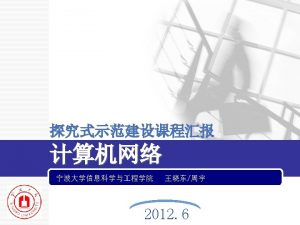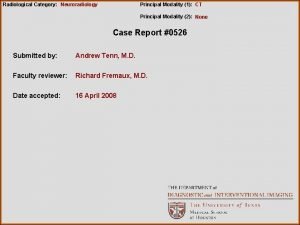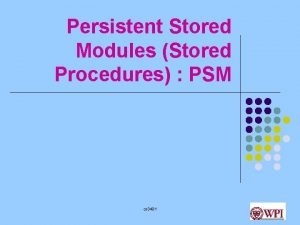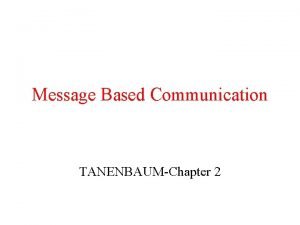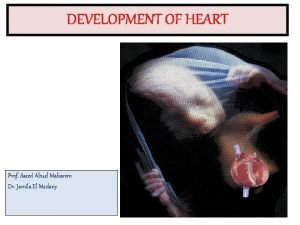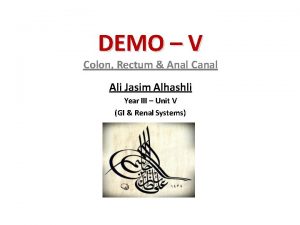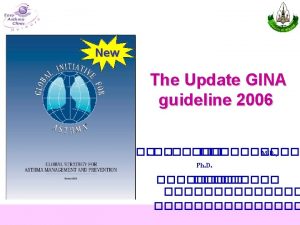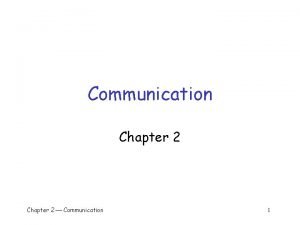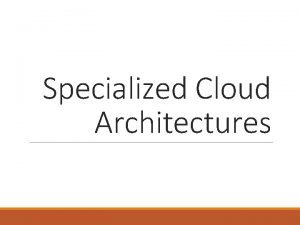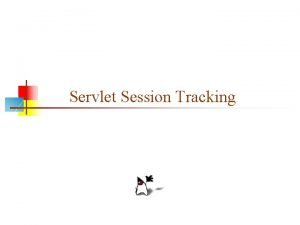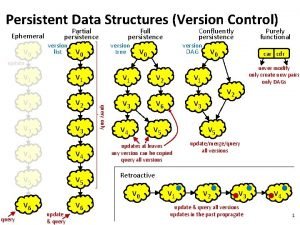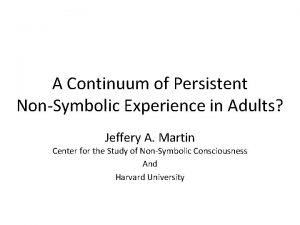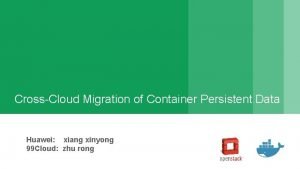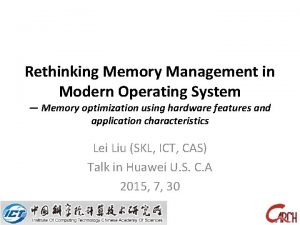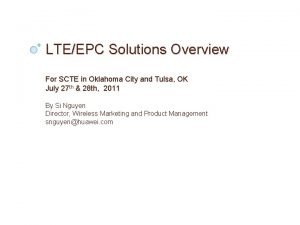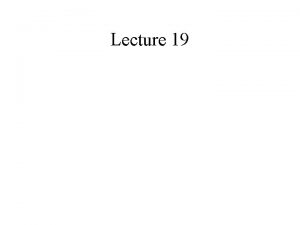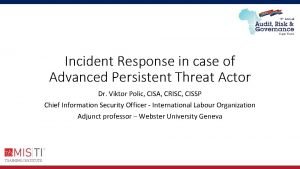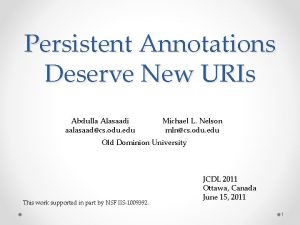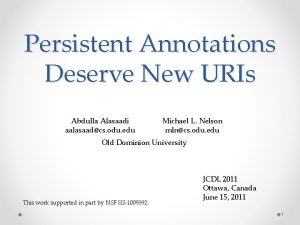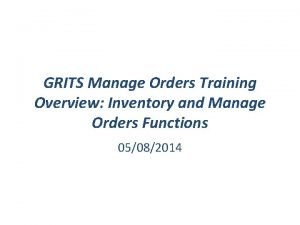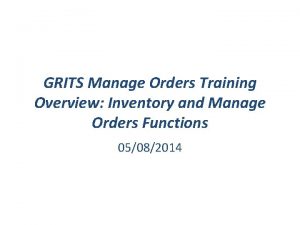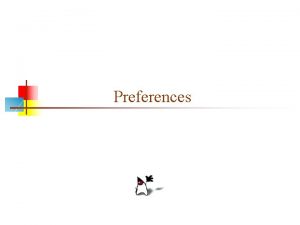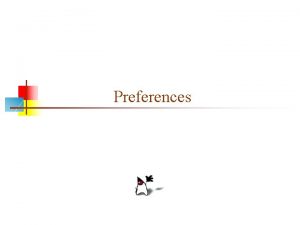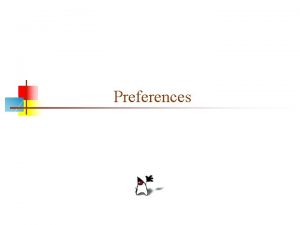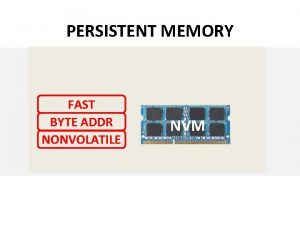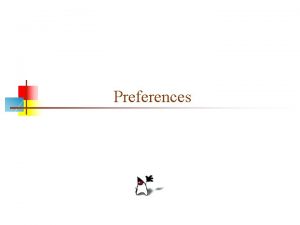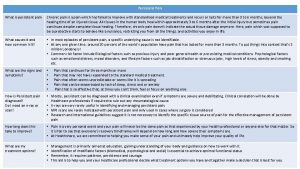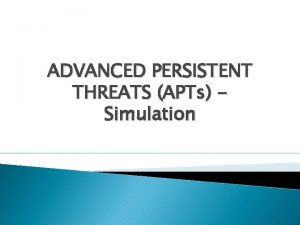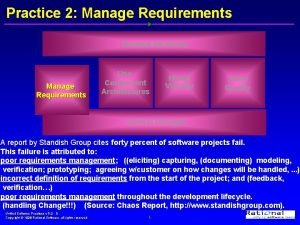Training Module 2 3 Design Manage Persistent URIs






























- Slides: 30

Training Module 2. 3 Design & Manage Persistent URIs Pw. C firms help organisations and individuals create the value they’re looking for. We’re a network of firms in 158 countries with close to 180, 000 people who are committed to delivering quality in assurance, tax and advisory services. Tell us what matters to you and find out more by visiting us at www. pwc. com. Pw. C refers to the Pw. C network and/or one or more of its member firms, each of which is a separate legal entity. Please see www. pwc. com/structure for further details.

This presentation has been created by Pw. C Presentation metadata Open Data Support is funded by the European Commission under SMART 2012/0107 ‘Lot 2: Provision of services for the Publication, Access and Reuse of Open Public Data across the European Union, through existing open data portals’(Contract No. 30 -CE 0530965/00 -17). © 2014 European Commission Authors: Nikolaos Loutas, Michiel De Keyzer and Stijn Goedertier Disclaimers 1. The views expressed in this presentation are purely those of the authors and may not, in any circumstances, be interpreted as stating an official position of the European Commission. The European Commission does not guarantee the accuracy of the information included in this presentation, nor does it accept any responsibility for any use thereof. Reference herein to any specific products, specifications, process, or service by trade name, trademark, manufacturer, or otherwise, does not necessarily constitute or imply its endorsement, recommendation, or favouring by the European Commission. All care has been taken by the author to ensure that s/he has obtained, where necessary, permission to use any parts of manuscripts including illustrations, maps, and graphs, on which intellectual property rights already exist from the titular holder(s) of such rights or from her/his or their legal representative. 2. This presentation has been carefully compiled by Pw. C, but no representation is made or warranty given (either express or implied) as to the completeness or accuracy of the information it contains. Pw. C is not liable for the information in this presentation or any decision or consequence based on the use of it. . Pw. C will not be liable for any damages arising from the use of the information contained in this presentation. The information contained in this presentation is of a general nature and is solely for guidance on matters of general interest. This presentation is not a substitute for professional advice on any particular matter. No reader should act on the basis of any matter contained in this publication without considering appropriate professional advice. Slide 2

Learning Objectives By the end of this training module you should have an understanding of: • What is a Uniform Resource Identifier (URI) is. • Why is URI persistence important. • How to design and manage persistent URIs for data resources. Slide 3

Content This module contains. . . • An introduction to Uniform Resource Identifiers (URI). • A set of design principles for building persistent URIs. • Service requirements for persistent URIs. Slide 4

Uniform Resource Identifiers (URIs) As common identifiers for things, e. g. people, buildings, locations, information resources. . . Slide 5

What is a URI? A URI is “a compact sequence of characters that identifies an abstract or physical resource” [TBL et al, 2005]. • “compact” means that the string must contain no white-space padding; • “abstract or physical” means that the URI may refer to a realworld object (or thing), e. g. a person, a building or even abstract ideas like a service, or to a Web document. Slide 6

For example. . . BE A country, e. g. Belgium - http: //publications. europa. eu/resource/authority/country/BEL An organisation, e. g. the Publications Office of the EU - http: //publications. europa. eu/resource/authority/corporate-body/PUBL A dataset, e. g. Country Name Authority List - http: //publications. europa. eu/resource/authority/country / Slide 7

Key principles • Persistent , i. e. a URI permanently assigned to a particular resource. It is stable and does not change or vanish over time. • Dereferencable, i. e. a user agent can make a request to that URI over the Internet and receive a meaningful response back. § If the user agent is a Web browser, then what comes back should be a human readable HTML document. § If the user agent is an RDF client then RDF should be returned from the same URI. • Unambiguous, i. e. here should be no confusion between identifiers for Web documents and identifiers for other resources. § There should be a different URI for referencing the author of a Web page and the Web page itself. Slide 8

Key assumptions • In order to create and manage URIs, one should be the owner of the respective Internet domain and have administrator’s rights on it. • For government domains, it is very likely that this is managed by a central agency. So please check with your colleagues before starting. • Persistent and dereferencable URIs must be supported by a trusted underlying Web infrastructure. Such an infrastructure may be available in house in your organisation or may be provided by a different organisation – e. g. as a shared resource. So please check with your IT colleagues before starting. Slide 9

What if a URI is not dereferencable and/or persistent? Imagine the following situation. . . Let’s resolve the description of “Ireland” from the countries code -list. http: //foo. org/concept_tid Resource not found Slide 10

Designing persistent URIs for datasets 10 Dos and Dont’s Slide 11

Follow a generic URI format http: //{domain}/{type}/{concept}/{reference} • {domain} is a combination of the host and the relevant sector. • {type} should be one of a small number of possible values that declare the type of resource that is being identified. Typical examples include: - 'id' or 'item' for real-world objects; - 'doc' for documents that describe those objects; - 'def' for concepts; - 'set' for datasets; - a string specific to the context. • {concept} might be a collection, the type of real-world object identified or the name of the concept scheme; • {reference} is a specific item, term or concept. Slide 12

Mint URIs reusing existing identifiers • Existing identifiers of resources, e. g. database keys, should be incorporated into the URI. § Reuse identifiers that themselves are likely to be persistent. § Reuse standard identifiers rather than internal system-specific codes. • For example, if the identifier of a company in a national business register is a string like AB 123456, then the URI for this company could be: http: //businessdata. gov/id/company/AB 123456 Slide 13

Implement 303 URIs for real-world resources • As no suitable representation exists for a real-world resources (i. e. a non-document resources such as a person, business, location. . . ) it is useful to be directed to a Web document which holds information about that resources. • Avoids ambiguity between the real-world resource and the document that represents it. • For example, if a government decides to create 303 URIs to represent primary schools, the result may be: § http: //schools. gov. foo/id/school 1 § http: //schools. gov. foo/id/school 2 See also: Cool URIs for the Semantic Web. http: //www. w 3. org/TR/cooluris/ Slide 14

Dereferencing 303 URIs and content-negotiation • When dereferenced, the URIs of these resources should respond with HTTP 303 to a document that describes the object. • The Web server needs to be configured to redirect: § from http: //schools. gov. foo/id/school 1 § To http: //schools. gov. foo/doc/school 1 • A URI re-write rule is in place, typically replacing the URI {type} of ‘id’ with ‘doc’ • Different representations are possible, e. g. RDF, XML, HTML. . . http: //schools. gov. foo/id/school 1 http: //schools. gov. foo/doc/school 1 http: //schools. gov. foo/do c/school 1. rdf c/school 1. html See also: Cool URIs for the Semantic Web. http: //www. w 3. org/TR/cooluris/ Slide 15

Avoid including version numbers in the URIs • Datasets, concept schemes, ontologies, taxonomies and vocabularies are released in successive versions following iterative cycles of change/update. • The URIs should remain stable between versions. § Version numbers and status information should not be included in the URI. • For example, imaging two consecutive releases, v 0. 01 and v 0. 02 of the schools dataset. If version information was included in the URI, then the URI of the dataset has to change every time a new release is out. § http: //schools. gov. foo/set/0. 01/schools § http: //schools. gov. foo/set/0. 02/schools Slide 16

Avoid using auto-increment when minting new URIs • Simply incrementing a counter when creating URIs for a large dataset may be simple, but can result in serious problems. § What happens if the dataset is updated and URIs have to be assigned again. How can we ensure that the sequence will be the same? Does this mean I should never do it? The use of auto-increment in URIs may be considered, when: § the process will never be repeated; § the process can be repeated to create exactly the same URIs for the same input data with new URIs minted only for new items. Slide 17

Avoid using query strings • A query string (e. g. ‘? param=value’) is text appended at the end of a URL that contains data to be passed to Web applications, e. g. search parameters to look up terms in a database. § Query strings are not persistent as they rely on particular implementations. Therefore, they should be avoided from URIs. • For example, imagine that the URI of a company published by a national business register (NBR) was http: //businessdata. gov/NBR/id/company? id=“AB 123456” instead of http: //businessdata. gov/NBR/id/company/AB 123456 Slide 18

Avoid including information about ownership • A persistent URI template should not include the name of the organisation or project that minted the URI. • For example, imagine that the URI of a company published by a national business register (NBR) was http: //businessdata. gov/NBR/id/company/AB 123456 • After a couple of years NBR is renamed to national company register (NCR). Hence all URIs have to be updated. • In this case a URI designed for persistence would be http: //businessdata. gov/id/company/AB 123456 Slide 19

Avoid using file extensions • File extensions reveal the file type of specific document. • The use of file extensions should be avoided in persistent URIs. • For example, the URI of a dataset containing the list of schools in a Member State would rather be § http: //data. gov. foo/set/schools than § http: //data. gov. foo/set/schools. csv • The file extension can be part of the document’s metadata. § e. g. dcat: media. Type in the Data Catalogue Vocabulary of W 3 C for describing datasets. Slide 20

Serving persistent URIs for data resources Slide 21

Use a dedicated service • A dedicated, trusted service that is independent of the data originator has to be put in place. • Easy to be transferred and run by someone else if necessary. § Dublin Core uses purl. org § data. gov. uk and publications. europa. eu are all also independent of a specific government department • Not necessary to adopt a single service for multiple data providers. § Higher risk as this would be a single point of failure, but § Easier to manage and more cost-efficient. Slide 22

Conclusions A URI is “a compact sequence of characters that identifies an abstract or physical resource”. See also: 10 Rules for Persistent URIs. https: //joinup. ec. europa. eu/node/53858 / Slide 23

Group questions Does your country have a national URI policy? If so, which are the key principles? http: //www. visualpharm. com Does your country have in place a dedicated service for URI persistency? If so, which organisation is managing this service? If not, why? Take also the online test here! Slide 24

Thank you!. . . and now YOUR questions? Slide 25

References Slide 6: • T. Berners-Lee, R. Fielding and L. Masinter (2005) "Uniform Resource Identifier (URI): Generic Syntax". http: //tools. ietf. org/html/rfc 3986 Slides 11 -22: • UK Government, CTO Council, Designing URI sets of the UK Public Sector. https: //www. gov. uk/government/uploads/system/uploads/attachment_data/file /60975/designing-URI-sets-uk-public-sector. pdf • EC ISA Programme, Study on persistent URIs, with identification of best practices and recommendations on the topic for the MSs and the EC. https: //joinup. ec. europa. eu/community/semic/document/10 -rules-persistenturis Slides 14 -15: • Cool URIs for the Semantic Web, http: //www. w 3. org/TR/cooluris Slide 26

Further reading (1/2) T. Berners-Lee, R. Fielding and L. Masinter (2005) "Uniform Resource Identifier (URI): Generic Syntax". http: //tools. ietf. org/html/rfc 3986 UK Government, CTO Council, Designing URI sets of the UK Public Sector. https: //www. gov. uk/government/uploads/system/uploads/attachme nt_data/file/60975/designing-URI-sets-uk-public-sector. pdf EC ISA Programme, Study on persistent URIs, with identification of best practices and recommendations on the topic for the MSs and the EC. https: //joinup. ec. europa. eu/community/semic/document/10 rules-persistent-uris Slide 27

Further reading (2/2) Linked Data: Evolving the Web into a Global Data Space. Tom Heath and Christian Bizer. http: //linkeddatabook. com/editions/1. 0/ Slide 28

Related projects and initiatives LOD 2 FP 7 project, http: //lod 2. eu W 3 C Cool URIs for the Semantic Web § http: //www. w 3. org/TR/cooluris § http: //www. w 3. org/wiki/Good. URIs URI Design Principles: Creating Unique URIs for Government Linked Data, http: //logd. tw. rpi. edu/instance-hub-uri-design Publications Office of the European Commission, http: //publications. europa. eu Data. gov. uk, http: //data. gov. uk/linked-data Slide 29

Be part of our team. . . Find us on Join us on Open Data Support http: //www. slideshare. net/Open. Data. Support Open Data Support http: //goo. gl/y 9 ZZI Follow us @Open. Data. Support http: //www. opendatasupport. eu Contact us contact@opendatasupport. eu Slide 30
 Persistent vs non persistent http
Persistent vs non persistent http Lab 5: manage active directory accounts (module 4)
Lab 5: manage active directory accounts (module 4) Training module design template
Training module design template C device module module 1
C device module module 1 Hardworking, industrious, not lazy
Hardworking, industrious, not lazy Persistent stapedial artery
Persistent stapedial artery Persistent stored modules
Persistent stored modules Pid identifier
Pid identifier Persistent and transient communication
Persistent and transient communication Icd 10 code for ocular allergies
Icd 10 code for ocular allergies Persistent elevation meaning
Persistent elevation meaning Slide todoc.com
Slide todoc.com Colon and rectum
Colon and rectum Asthma classifications
Asthma classifications Silk glove sign
Silk glove sign Transient synchronous communication
Transient synchronous communication Logical network perimeter
Logical network perimeter Session tracking in servlet
Session tracking in servlet Persistent vs ephemeral data structures
Persistent vs ephemeral data structures Persistent non symbolic experience
Persistent non symbolic experience Persistent data container
Persistent data container Persistent currents
Persistent currents Persistent currents
Persistent currents Hessah vessel
Hessah vessel Rethinking file mapping for persistent memory
Rethinking file mapping for persistent memory Oge normal conformate
Oge normal conformate Persistent slip bands
Persistent slip bands Persistent currents
Persistent currents Semi-persistent scheduling
Semi-persistent scheduling Tunelling
Tunelling Advanced persistent threat assessment
Advanced persistent threat assessment
